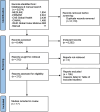Human resources for health: a framework synthesis to put health workers at the centre of healthcare
- PMID: 39317468
- PMCID: PMC11429363
- DOI: 10.1136/bmjgh-2023-014556
Human resources for health: a framework synthesis to put health workers at the centre of healthcare
Abstract
Background: Human resources are a key determinant for the quality of healthcare and health outcomes. Several human resource management approaches or practices have been proposed and implemented to better understand and address health workers' challenges with mixed results particularly in low- and middle-income countries (LMICs). The aim of this framework synthesis was to review the human resources frameworks commonly available to address human resources for health issues in LMIC.
Methods: We searched studies in Medline, Embase, CAB Global Health, CINAHL (EBSCO) and WHO global Index Medicus up to 2021. We included studies that provided frameworks to tackle human resources for health issues, especially for LMICs. We synthesised the findings using a framework and thematic synthesis methods.
Results: The search identified 8574 studies, out of which 17 were included in our analysis. The common elements of different frameworks are (in descending order of frequency): (1) functional roles of health workers; (2) health workforce performance outcomes; (3) human resource management practises and levers; (4) health system outcomes; (5) contextual/cross-cutting issues; (6) population health outcomes and (7) the humanness of health workers. All frameworks directly or indirectly considered themes around the functional roles of health workers and on the outcomes of health workforce activities, while themes concerning the humanness of health workers were least represented. We propose a synthesised Human-Centred Health Workforce Framework.
Conclusions: Several frameworks exist providing different recurring thematic areas for addressing human resources for health issues in LMIC. Frameworks have predominantly functional or instrumental dimensions and much less consideration of the humanness of health workers. The paradigms used in policy making, development and funding may compromise the effectiveness of strategies to address human resources challenges in LMIC. We propose a comprehensive human resources for health framework to address these pitfalls.
Keywords: Health policy; Health services research; Health systems; Systematic review.
© Author(s) (or their employer(s)) 2024. Re-use permitted under CC BY-NC. No commercial re-use. See rights and permissions. Published by BMJ.
Conflict of interest statement
Competing interests: None declared.
Figures



References
-
- Campbell J, Dussault G, Buchan J, et al. Global Health Workforce Alliance and World Health Organisation: Geneva; 2013. [27-Feb-2024]. A universal truth: no health without a workforce. Forum report, third globalforum on human resources for health, Recife, Brazil.https://cdn.who.int/media/docs/default-source/healthworkforce/ghwn/ghwa/... Available. Accessed.
-
- World Health Organization The world health report 2006: working together for health. Geneva. 2006. [27-Feb-2024]. https://iris.who.int/bitstream/handle/10665/43432/9241563176_eng.pdf Available. Accessed.
-
- World Health Organsiation . Geneva: World Health Organization; 2007. [27-Feb-2024]. Everybody business: strengthening health systems to improve health outcomes: WHO’s framework for action.https://iris.who.int/bitstream/handle/10665/43918/9789241596077_eng.pdf?... Available. Accessed.
Publication types
MeSH terms
LinkOut - more resources
Full Text Sources
